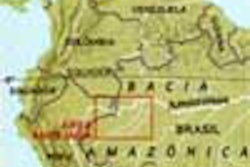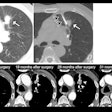
Sydney Possuelo is on a mission. A tireless defender of indigenous peoples in Brazil's Amazon rainforest, Possuelo next week will embark on the latest of his frequent trips upriver to explore and make contact with indigenous tribes. But this time he'll be bringing something new into the jungle: medical imaging technology to find and diagnose a series of Western diseases that have devastated native peoples in the Amazon's Vale do Javari region.
On April 5, the Imagem do Javari Expedition will leave by boat from the Brazilian town of Tabatinga, near the intersection of the borders of Brazil, Peru, and Colombia. The boat, named the Kukaha after a tributary of the Amazon, will carry 15 people, including Possuelo, a radiologist, and an armamentarium of imaging equipment.
Their mission is to help prevent the spread of disease in the Vale do Javari by using medical imaging to screen between 800-1,000 members of the Matis, Marubo, Kanamari, and Korubo tribes. Stopping at villages along the river, members of the tribes will be brought on board the Kukaha for imaging studies designed to detect infectious diseases such as hepatitis A, B and Delta; yellow fever; malaria; and tuberculosis. Primary care physicians aboard the boat will be available to provide first-line treatment.
 |
|
A tribesman from the Amazon rainforest.
|
Because of their isolation, many of these tribes have never developed immunities to diseases that are relatively easy to identify and treat in Western societies. When contact does occur between an Amazon tribe and the outside world, it's often disastrous -- infectious diseases can ravage a tribe before healthcare authorities can deliver effective treatments.
Possuelo has made repeated trips up the Amazon as part of a lifelong effort to protect the tribes from the outside world, and is now head the Department of Unknown Tribes within the Brazilian government's Federal Indian Department (FUNAI). It’s no surprise, then, that he was intrigued when a Brazilian radiologist pitched his idea for bringing medical imaging into the heart of the rainforest.
A lifelong dream
The genesis for the Imagem do Javari Expedition came from Dr. Sergio Brincas, a radiologist at Clínica Imagem in Florianópolis in southern Brazil. Brincas has been fascinated by the Amazon tribes since he was a child, and has dreamed of visiting them for years, he told AuntMinnie.com.
 |
|
Dr. Sergio Brincas.
|
Brincas saw that medical imaging could help alleviate some of the health problems suffered by the tribes, and pitched the idea of bringing medical imaging into the rainforest to Possuelo last year. Possuelo identified the region that would be best suited for the expedition to visit (go here for a short history of the Vale do Javari), and the expedition leaders made a test visit to the area in January.
The Kukaha has been outfitted to serve as a floating medical imaging clinic. On board are a portable x-ray system, a blood analysis laboratory, two computed radiography readers, a diagnostic review workstation, and PACS software with a satellite uplink for sending images to Brincas' clinic in Florianópolis. Two portable ultrasound scanners will also be on board. Everything is powered by a generator, Brincas said (go here for more details on the medical imaging equipment on board the Kukaha).
The operation is completely filmless, an important consideration in the pristine Amazon environment, Brincas said. "I believe this is almost a revolution in medicine," he said. "You can have the x-ray results without chemical substances and without creating pollution in the jungle."
It will take about 5-10 days for the boat to reach its first destination, Brincas said. At that point, it will drop anchor and begin screening individuals from the local tribe in the area. Most will be brought on board the Kukaha for imaging, but the portable ultrasound scanners will also be taken into the field.
Brincas can read images on the boat's 3-megapixel monitors, but will also be able to send studies to the imaging facility in Florianópolis and its staff of seven radiologists. In a twist on the traditional hub-and-spoke teleradiology model, images from Florianópolis will also be sent to the Kukaha for Brincas to review, so that his two-month absence from the clinic does not pose a burden on the rest of the staff. Backup images will also be sent to a facility in Sao Paolo for archiving.
 |
|
Expedition co-leader Bia Boleman.
|
Brincas has been a radiologist for 13 years, specializing in musculoskeletal radiology. His training included several months at the Armed Forces Institute of Pathology (AFIP) in Washington, DC.
Joining Brincas and Possuelo as co-leaders of the expedition is Bia Boleman, founder of Dunas e Ventos, an organization that has been coordinating expeditions through South America for over 20 years. Boleman is handling the organization and logistical details of the trip, Brincas said.
A people under siege
The expedition couldn't come at a more urgent time. The tribes of the Vale do Javari are beset by encroachment from the modern world, as the Amazon rainforest is cleared and loggers, miners, and farmers move in. Life expectancies have dropped markedly among tribes in the region, and now stands at 45-50 years, Brincas said.
There are some tribes in the area that haven't been contacted at all by "civilization"; it is these groups that are the focus of Possuelo's protection efforts. The expedition will avoid making contact with these tribes, Brincas said, instead focusing on the groups that live near them in hopes of stopping the spread of Western diseases. The members of the expedition themselves have been tested to ensure that they aren't carrying any diseases that could be spread to the tribes.
Brincas believes that the Imagem do Javari Expedition is the beginning of what should be a long-term effort to improve the health of indigenous tribes in the Amazon -- with radiology taking the lead.
"This is probably the first step in a long effort to correct and reestablish health in that population, the first step to creating a medical unit that goes forward to the patient," Brincas said. "This avoids the need to take all the patients to the doctor; you can keep the doctor in the city and take the technology to the patients."
By Brian Casey
AuntMinnie.com staff writer
April 2, 2004
Copyright © 2004 AuntMinnie.com



















